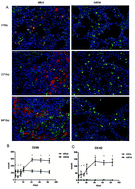Our official English website, www.x-mol.net, welcomes your
feedback! (Note: you will need to create a separate account there.)
Dendritic cells trigger imbalance of Th1/Th2 cells in silica dust exposure rat model via MHC-II, CD80, CD86 and IL-12
RSC Advances ( IF 3.9 ) Pub Date : 2018-07-20 00:00:00 , DOI: 10.1039/c8ra03970d Lei Bao 1 , Changfu Hao 1 , Suna Liu 2 , Lin Zhang 1 , Juan Wang 3 , Di Wang 1 , Yiping Li 1 , Wu Yao 1
RSC Advances ( IF 3.9 ) Pub Date : 2018-07-20 00:00:00 , DOI: 10.1039/c8ra03970d Lei Bao 1 , Changfu Hao 1 , Suna Liu 2 , Lin Zhang 1 , Juan Wang 3 , Di Wang 1 , Yiping Li 1 , Wu Yao 1
Affiliation

|
Silicosis is one of the most common occupational respiratory diseases caused by inhaling silica dust over a prolonged period of time, and the progression of silicosis is accompanied with chronic inflammation and progressive pulmonary fibrosis, in which dendritic cells (DCs), the most powerful antigen presentation cell (APC) in the immune response, play a crucial role. To investigate the role of DCs in the development of silicosis, we established an experimental silicosis rat model and examined the number of DCs and alveolar macrophages (AMs) in lung tissues using immunofluorescence over 84 days. Additionally, to obtain an overview of the immunological changes in rat lung tissues, a series of indicators including Th1/Th2 cells, IFN-γ, IL-4, MHC-II, CD80/86 and IL-12 were detected using flow cytometry and an enzyme-linked immunosorbent assay (ELISA) as well as a real-time polymerase chain reaction (PCR) assay. We observed that the number of DCs slightly increased at the inflammatory stage, and it increased significantly at the final stage of fibrosis. Polarization of Th1 cells and IFN-γ expressions were dominant during the inflammatory stage, whereas polarization of Th2 cells and IL-4 expressions were dominant during the fibrotic stage. The subsequent mechanistic study found that the expressions of MHC-II, CD80/86 and IL-12, which are the key molecules that connect DCs and Th cells, changed dynamically in the experimental silicosis rat model. The data obtained in this study indicated that the increase in DCs may contribute to polarization of Th1/Th2 cells via MHC-II, CD80/86, and IL-12 in silica dust-exposed rats.
中文翻译:

树突状细胞通过 MHC-II、CD80、CD86 和 IL-12 在硅尘暴露大鼠模型中引发 Th1/Th2 细胞失衡
矽肺是长期吸入矽尘引起的最常见的职业性呼吸系统疾病之一,矽肺的进展伴随着慢性炎症和进行性肺纤维化,其中树突状细胞(DCs)抗原呈递最强细胞(APC)在免疫反应中起着至关重要的作用。为了研究 DC 在矽肺发展中的作用,我们建立了实验性矽肺大鼠模型,并在 84 天内使用免疫荧光检查了肺组织中 DC 和肺泡巨噬细胞 (AM) 的数量。此外,为了了解大鼠肺组织的免疫学变化,一系列指标包括 Th1/Th2 细胞、IFN-γ、IL-4、MHC-II、使用流式细胞术和酶联免疫吸附试验 (ELISA) 以及实时聚合酶链反应 (PCR) 试验检测 CD80/86 和 IL-12。我们观察到 DCs 的数量在炎症阶段略有增加,在纤维化的最后阶段显着增加。Th1细胞的极化和IFN-γ表达在炎症阶段占主导地位,而Th2细胞的极化和IL-4表达在纤维化阶段占主导地位。随后的机理研究发现,在实验性矽肺大鼠模型中,连接DCs和Th细胞的关键分子MHC-II、CD80/86和IL-12的表达发生动态变化。本研究中获得的数据表明,DCs 的增加可能有助于 Th1/Th2 细胞的极化 我们观察到 DCs 的数量在炎症阶段略有增加,在纤维化的最后阶段显着增加。Th1细胞的极化和IFN-γ表达在炎症阶段占主导地位,而Th2细胞的极化和IL-4表达在纤维化阶段占主导地位。随后的机理研究发现,连接DCs和Th细胞的关键分子MHC-II、CD80/86和IL-12的表达在实验性矽肺大鼠模型中发生动态变化。本研究中获得的数据表明,DCs 的增加可能有助于 Th1/Th2 细胞的极化 我们观察到 DCs 的数量在炎症阶段略有增加,在纤维化的最后阶段显着增加。Th1细胞的极化和IFN-γ表达在炎症阶段占主导地位,而Th2细胞的极化和IL-4表达在纤维化阶段占主导地位。随后的机理研究发现,连接DCs和Th细胞的关键分子MHC-II、CD80/86和IL-12的表达在实验性矽肺大鼠模型中发生动态变化。本研究中获得的数据表明,DCs 的增加可能有助于 Th1/Th2 细胞的极化 Th1细胞的极化和IFN-γ表达在炎症阶段占主导地位,而Th2细胞的极化和IL-4表达在纤维化阶段占主导地位。随后的机理研究发现,连接DCs和Th细胞的关键分子MHC-II、CD80/86和IL-12的表达在实验性矽肺大鼠模型中发生动态变化。本研究中获得的数据表明,DCs 的增加可能有助于 Th1/Th2 细胞的极化 Th1细胞的极化和IFN-γ表达在炎症阶段占主导地位,而Th2细胞的极化和IL-4表达在纤维化阶段占主导地位。随后的机理研究发现,连接DCs和Th细胞的关键分子MHC-II、CD80/86和IL-12的表达在实验性矽肺大鼠模型中发生动态变化。本研究中获得的数据表明,DCs 的增加可能有助于 Th1/Th2 细胞的极化在二氧化硅粉尘暴露的大鼠中通过MHC-II、CD80/86 和 IL-12。
更新日期:2018-07-20
中文翻译:

树突状细胞通过 MHC-II、CD80、CD86 和 IL-12 在硅尘暴露大鼠模型中引发 Th1/Th2 细胞失衡
矽肺是长期吸入矽尘引起的最常见的职业性呼吸系统疾病之一,矽肺的进展伴随着慢性炎症和进行性肺纤维化,其中树突状细胞(DCs)抗原呈递最强细胞(APC)在免疫反应中起着至关重要的作用。为了研究 DC 在矽肺发展中的作用,我们建立了实验性矽肺大鼠模型,并在 84 天内使用免疫荧光检查了肺组织中 DC 和肺泡巨噬细胞 (AM) 的数量。此外,为了了解大鼠肺组织的免疫学变化,一系列指标包括 Th1/Th2 细胞、IFN-γ、IL-4、MHC-II、使用流式细胞术和酶联免疫吸附试验 (ELISA) 以及实时聚合酶链反应 (PCR) 试验检测 CD80/86 和 IL-12。我们观察到 DCs 的数量在炎症阶段略有增加,在纤维化的最后阶段显着增加。Th1细胞的极化和IFN-γ表达在炎症阶段占主导地位,而Th2细胞的极化和IL-4表达在纤维化阶段占主导地位。随后的机理研究发现,在实验性矽肺大鼠模型中,连接DCs和Th细胞的关键分子MHC-II、CD80/86和IL-12的表达发生动态变化。本研究中获得的数据表明,DCs 的增加可能有助于 Th1/Th2 细胞的极化 我们观察到 DCs 的数量在炎症阶段略有增加,在纤维化的最后阶段显着增加。Th1细胞的极化和IFN-γ表达在炎症阶段占主导地位,而Th2细胞的极化和IL-4表达在纤维化阶段占主导地位。随后的机理研究发现,连接DCs和Th细胞的关键分子MHC-II、CD80/86和IL-12的表达在实验性矽肺大鼠模型中发生动态变化。本研究中获得的数据表明,DCs 的增加可能有助于 Th1/Th2 细胞的极化 我们观察到 DCs 的数量在炎症阶段略有增加,在纤维化的最后阶段显着增加。Th1细胞的极化和IFN-γ表达在炎症阶段占主导地位,而Th2细胞的极化和IL-4表达在纤维化阶段占主导地位。随后的机理研究发现,连接DCs和Th细胞的关键分子MHC-II、CD80/86和IL-12的表达在实验性矽肺大鼠模型中发生动态变化。本研究中获得的数据表明,DCs 的增加可能有助于 Th1/Th2 细胞的极化 Th1细胞的极化和IFN-γ表达在炎症阶段占主导地位,而Th2细胞的极化和IL-4表达在纤维化阶段占主导地位。随后的机理研究发现,连接DCs和Th细胞的关键分子MHC-II、CD80/86和IL-12的表达在实验性矽肺大鼠模型中发生动态变化。本研究中获得的数据表明,DCs 的增加可能有助于 Th1/Th2 细胞的极化 Th1细胞的极化和IFN-γ表达在炎症阶段占主导地位,而Th2细胞的极化和IL-4表达在纤维化阶段占主导地位。随后的机理研究发现,连接DCs和Th细胞的关键分子MHC-II、CD80/86和IL-12的表达在实验性矽肺大鼠模型中发生动态变化。本研究中获得的数据表明,DCs 的增加可能有助于 Th1/Th2 细胞的极化在二氧化硅粉尘暴露的大鼠中通过MHC-II、CD80/86 和 IL-12。










































 京公网安备 11010802027423号
京公网安备 11010802027423号